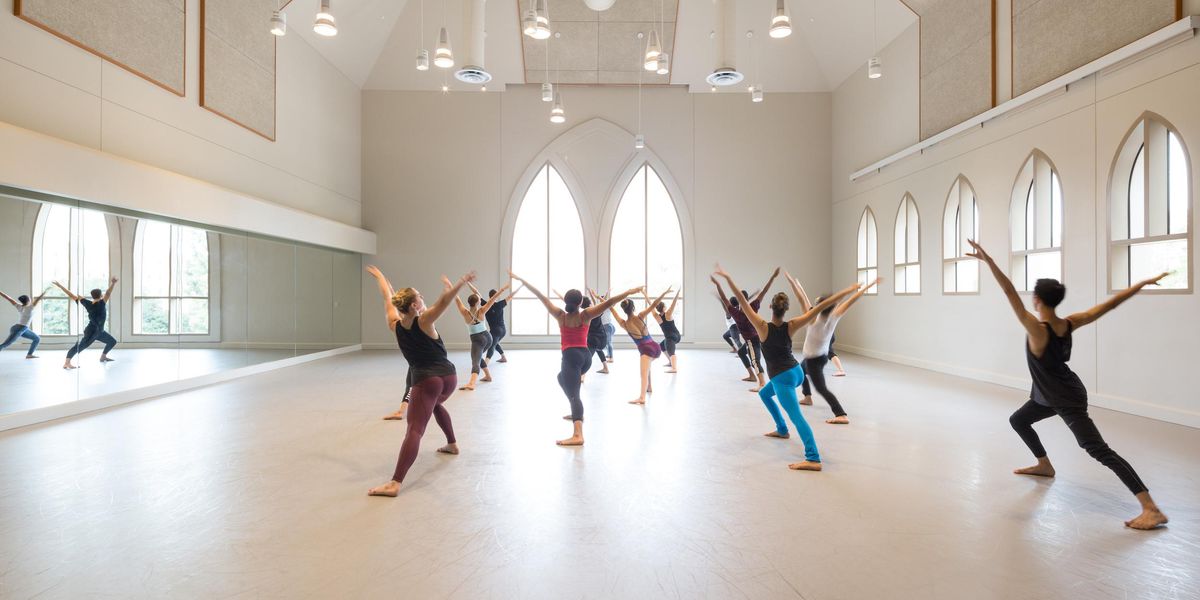Summer Study Guide 2012: Learning from the Masters
At Steps on Broadway, summer brings classes and auditions with top-notch contemporary choreographers.
Sean Curran teaches at Steps with Contemporary Masters. Photo by Paul B. Goode, Courtesy Steps.
Andrea Miller, artistic director of Gallim Dance, begins to move, her body bending and curving to a gentle, internal rhythm as she leads a Gaga-based, improv warm-up. Her class faces away from the mirror and toward one of the window-lined walls overlooking upper Broadway. The students—many of them professionals and pre-professionals with schedules full of rehearsals, performances, and side jobs—let go of the pressures of both the outside world and the mirror. Sunlight filters in, the noise of the street a distant hum, as they explore their own movement. “I am also not a mirror,” Miller says as her energy builds. This is not a moment for judgment, internal or external; this is a moment for a personal connection to moving.
It’s the first day of Miller’s week-long workshop through Steps with Contemporary Masters, a special summer treat at Steps on Broadway in Manhattan. Each summer, Steps opens one of its spacious studios to 13 or 14 mini-intensives, composed of daily two-hour afternoon master classes led by a different choreographer each week. As an added plus, choreographers can choose to hold an end-of-workshop audition, giving students a chance to apply what they’ve learned and, possibly, to leave the studio with a job.
The classes offer what is advertised as “technique, repertory, movement exploration, and creation,” as well as an opportunity to work with some of today’s most colorful and sought-after contemporary dancemakers. Since bringing the program to Steps in the mid-1990s, co-artistic/managing director Diane Grumet has endeavored each year to bring in a diverse group of artists who offer a taste of what is happening in the contemporary dance world. “I look for choreographers who are compelling to me in terms of either their process or their performance,” she says. “There’s always something that gains attention or is new, different, or intelligent about these people.” Classes last summer ranged from the comedic physicality of Monica Bill Barnes, to the highly technical movement of Desmond Richardson and Dwight Rhoden.
The series allows students to take a full week of classes or to drop in as they wish. “After working with dancers for a week,” Grumet says, “the choreographers become interested in the dancers, so it’s a mutually beneficial experience. The dancers get exposure, and the choreographers also get exposed to dancers, with the opportunity to explore in an environment without criticism.”
Coupled with the auditions that some choreographers hold, this can be good news. Donald Byrd and Sean Curran have both found dancers through Steps, as has Pascal Rioult. Last summer, Rioult took two apprentices and one understudy, all of whom had attended his class at Steps before auditioning. Sara Seger, one of the apprentices, feels that her three days in class with Rioult were integral to her success. “On a scale of 1 to 10, 10 being the most helpful, taking class would probably be about an 8 or 9,” she says. “I don’t know for sure, but I think that a lot of me getting hired had to do with my being in class that week prior.”
With or without an audition, Steps with Contemporary Masters can be an exciting laboratory for dancers looking to try new ways of moving. As a drop-in student last summer, I felt pushed both physically and creatively in classes with Miller, Curran, Barnes, and Aszure Barton. Barton challenged us with complicated counts, musical counterpoint, and quirky, technically difficult repertoire or movement that she created on the spot. Barnes explored the idea of performing and asked us to think about commitment to even mundane movement. (When did you last explore the artistic strength of a well-performed jazz square?) Curran’s class, on the other hand, incorporated movement drawn from the techniques of Cunningham and Limón.
I spent the most time in class with Miller, who taught in the eighth week of the series. Throughout the week she led us through different aspects of her movement vocabulary, incorporating Gaga, general improvisation, repertory, and, on day two, what she termed “party tricks,” which consisted of impressive floorwork.
For fellow student Marygrace Patterson, a Barnard College senior, the party tricks in Miller’s class were a highlight. The class “deconstructed things that I never would have done otherwise and that might have gotten thrown at me in a different situation,” says Patterson. “I left feeling like I’d really accomplished something.”
Steps’ New York location is appealing as well. Miller feels that “just being at Steps and taking class, meeting the other dancers that are coming to those classes and talking about the dance scene,” offers a solid introduction to the New York dance world. “I think the master series is a good filter down to the really exciting work that’s happening, and also to the dancers that are up to date with it. I would really recommend it to new visitors and new members of the New York community,” says Miller.
Though it’s not your typical summer intensive, Steps with Contemporary Masters offers a great alternative to traditional summer dance plans. It provides an opportunity to branch out and explore the wide array of work being made today, while also offering the potential to develop new connections. I ended last summer with a deeper appreciation for the diversity of the contemporary dance world and a richer palette of movement vocabularies, challenging myself to try new things along the way. And the best part? I had fun.
Inset: Master class with Jacqulyn Buglisi. Photo by Paul B. Goode, Courtesy Steps.
Elena Hecht is a dancer and writer based in NYC.




